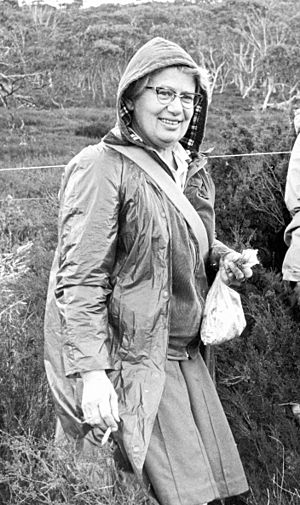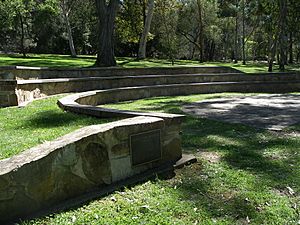Nancy Tyson Burbidge facts for kids
Nancy Tyson Burbidge (born August 5, 1912 – died March 4, 1977) was an amazing Australian scientist. She was a botanist, which means she studied plants. Nancy also worked to protect nature and managed a special collection of plants called a herbarium.
Contents
Early Life and Education
Nancy Burbidge was born in Cleckheaton, England. When she was very young, her family moved to Western Australia in 1913. Her father was a clergyman.
Nancy went to school at Kobeelya Church of England Girls' School. Her mother, Nancy Eleanor, actually started this school! Nancy finished high school in 1922. She then went to the University of Western Australia.
In 1937, Nancy earned her first degree in science. She won a special prize to travel to England. There, she spent 18 months at the Kew Gardens. While at Kew, she studied a type of Australian grass called Enneapogon. When she returned to Australia, she continued her studies and earned her master's degree in 1945.
A Career Studying Plants
In 1943, Nancy started working at the Waite Agricultural Research Institute in Adelaide. She studied native plants that grew in dry areas of South Australia.
In 1946, Nancy got a new job at the CSIRO in Canberra. She was a systematic botanist. This meant she helped organize and grow the CSIRO's plant collection, known as a herbarium. She helped create the foundations of what is now the National Australian Herbarium.
Nancy was very involved in the world of botany. She was a secretary for a botany committee from 1948 to 1952. She also edited a newsletter called Australasian Herbarium News.
In 1953, Nancy took a year off to work at Kew Gardens again. This time, she was the Australian Botanical Liaison Officer. She took photos and made copies of important notes about Australian plants. These copies were for herbaria back in Australia.
Important Works and Conservation
When Nancy returned to Australia in 1954, she had a very busy and successful time. In 1960, she wrote a big paper about where different plants grow in Australia. This work helped her earn her doctorate degree in 1961.
In 1963, her book Dictionary of Australian Plant Genera was published. She also studied specific plant groups like Nicotiana (tobacco plants), Sesbania, and Helichrysum. Many of her publications included her own detailed drawings.
Later, Nancy played a huge role in creating the Flora of Australia book series. This series describes all the plants in Australia. She led this project from 1973 until her death in 1977. Besides her books, she wrote over 50 papers about plants and nature.
Nancy was also very interested in protecting nature. She helped start the National Parks Association of the Australian Capital Territory in 1960. She was even its president twice! She worked hard to get national parks created in the ACT, like Tidbinbilla Nature Reserve and Namadgi National Park. These parks were established after she passed away.
Awards and Recognition
Nancy Burbidge received many honors for her work.
- In 1971, she was given the Clarke Medal for her achievements in studying plants and ecology. This award came from the Royal Society of New South Wales.
- In 1976, she was made a member of the Order of Australia. This is a very high honor in Australia.
Nancy's contributions are remembered in several ways:
- There is a special fabric artwork showing Australian plants and birds in a church in Mount Pleasant, Western Australia.
- The Nancy T. Burbidge Memorial is an amphitheatre in the Australian National Botanic Gardens in Canberra.
- The Australian Plant Name Index, a big list of Australian plant names, is dedicated to her.
- A mountain in Namadgi National Park is named Mount Burbidge in her honor.
- A type of wattle tree, Acacia burbidgeae, is also named after her.
The Australian Systematic Botanists Society gives out the 'Nancy T. Burbidge medal' every year. It's for people who have made great contributions to studying Australian plants.
The Australian National Herbarium has over 7,000 plant samples that Nancy Burbidge collected! Other plant collections across Australia also hold her specimens.
Standard Author Abbreviation
See also
 In Spanish: Nancy Tyson Burbidge para niños
In Spanish: Nancy Tyson Burbidge para niños



